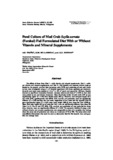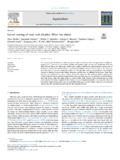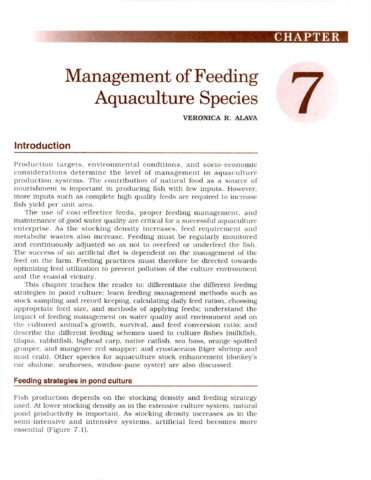Pond culture of mud crab Scylla serrata (Forskal) fed formulated diet with or without vitamin and mineral supplements

Associated URL
www.asianfisheriessociety.orgDate
2001Page views
465Metadata
Show full item record
Share
Abstract
The effects of three diets (Diet 1 – with vitamin and mineral supplements, Diet 2 – without vitamin and mineral supplements, and Diet 3 – fish bycatch) and monosex culture (male or female) on the growth, survival, feed conversion ratio (FCR), and production of mud crab Scylla serrata were investigated using a 2 x 3 factorial experiment with three replicates per treatment. Juvenile mud crabs were stocked at 1.0·m-2 in 150 m2 ponds and reared for 156 days. Results showed no significant interaction between monosex culture and diets (P > 0.05) so that data were pooled by sex and dietary treatment. Mean final body weight of male crabs (427 g) was significantly higher (P < 0.05) than female crabs (400 g). However, crab carapace length (CL) and width (CW), specific growth rate (SGR), FCR, survival, and production were not significantly different (P > 0.05) between the two sexes. Regardless of sex, crabs fed fish bycatch (Diet 3) gave significantly higher (P < 0.05) mean body weight (435 g) than those fed Diet 2 (395 g). Mean final body weight (410 g) of crabs fed Diet 1 was not significantly different from those fed Diets 2 or 3. The CL and CW, SGR, FCR, survival, and production of mud crabs fed the three diets, however, were not significantly different (P > 0.05). The economic viability of using a diet without vitamin and mineral supplements was comparable to that of a complete diet having about the same cost of production and return on investment of 74 to 75%. The study shows that cost-effective formulated diet could be used as alternative feed for fish bycatch thus saving on feed and storage costs.
Suggested Citation
Triño, A. T., Millamena, O. M., & Keenan, C. P. (2001). Pond culture of mud crab Scylla serrata (Forskal) fed formulated diet with or without vitamin and mineral supplements. Asian Fisheries Science , 14(2), 191-200. http://hdl.handle.net/10862/1914
Subject
Taxonomic term
Collections
- AQD Journal Articles [1249]
Related items
Showing items related by title, author, creator and subject.
-
Larval rearing of mud crab (Scylla): What lies ahead
Waiho, Khor; Fazhan, Hanafiah; Quinitio, Emilia T.; Baylon, Juliana C.; Fujaya, Yushinta; Azmie, Ghazali; Wu, Qingyang; Shi, Xi; Ikhwanuddin, Mhd; Ma, Hongyu (Elsevier, 2018)The increasing global demand for mud crabs (genus Scylla) and threats to the wild populations highlight the urgency of fully rearing them in captivity. Despite considerable progress in mud crab production, most crab farms ... -
Mud crab pond and pen culture
Rodriguez, Eduard M. (University of the Philippines Aquaculture Society, Inc, 2001) -
Management of feeding aquaculture species
Alava, Veronica R. (Aquaculture Department, Southeast Asian Fisheries Development Center, 2002)This chapter teaches the reader to: differentiate the different feeding strategies in pond culture; learn feeding management methods such as stock sampling and record keeping, calculating daily feed ration, choosing ...





